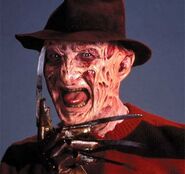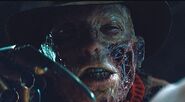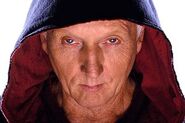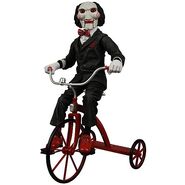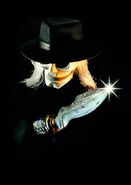For other uses, see wikipedia:Horror
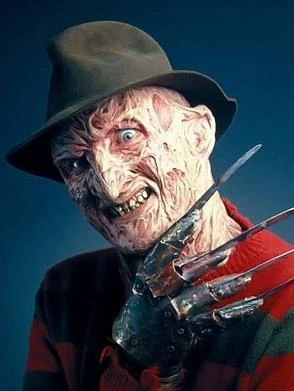
Freddy Krueger is by far the most popular horror character. He has been ranked the 14th greatest villain by Wizard magazine, the 8th greatest villain by the British television channel Sky2, and the 40th greatest villain by the American Film Institute on it's "AFI's 100 Years... 100 Heroes and Villains" list. He has also been deemed the 1st greatest horror villain, the 2nd being Jason Voorhees.
Horror films are unsettling movies that strive to elicit the emotions of fear, disgust and horror from viewers. They usually feature frequent jump scenes that make the viewers jump and startled through the means of macabre and the supernatural, thus frequently overlapping with the fantasy and science fiction genres. Horrors also frequently overlap with the thriller genre.
Horror films deal with the viewer's nightmares, hidden worst fears, revulsions and terror of the unknown. Although a good deal of it is about the supernatural, if some films contain a plot about morbidity, serial killers (especially Halloween-themed), a disease/virus oubtreak and surrealism, they may be termed "horror".
Its plots often involve the intrusion of an evil force, event, or personage, mainly of supernatural origin, into the everyday world. Some of the most common elements of horror films are ghosts, torture, gore, werewolves, ancient curses, satanism, demons, vicious animals, vampires, cannibals, haunted houses, zombies and masked serial killers. Conversely, many stories of the supernatural do not have to be, and are not, horror.
What's considered to be a horror film has varied from decade to decade. Films that were once called horror, would now be categorised as thrillers (The Silence of the Lambs, Jaws, Psycho, Seven). These days, the term "horror" is applied to films which display more explicit gore, jump scenes/scares or supernatural content (Wes Craven's New Nightmare, A Tale of Two Sisters, Saw films, The Strangers, The Ring, Session 9).
Early horror movies are largely based on classic literature of the gothic/horror genre, such as Dracula, Frankenstein, The Phantom of the Opera, and Dr. Jekyll and Mr. Hyde. More recent horror films continue to exploit the monsters of literature.
History
1890s–1920s
The first depictions of supernatural events appear in several of the silent shorts created by film pioneers such as Georges Méliès in the late 1890s, the most notable being his 1896 Le Manoir du diable (aka "The House of the Devil") which is sometimes credited as being the first horror film. Another of his horror projects was 1898's La Caverne maudite (aka "The Cave of the unholy one", literally "the accursed cave"). Japan made early forays into the horror genre with Bake Jizo and Shinin no Sosei, both made in 1898. In 1910, Edison Studios produced the first film version of Frankenstein; thought lost for many years, film collector Alois Felix Dettlaff Sr. found a copy and had a 1993 rerelease.
The early 20th century brought more milestones for the horror genre including the first monster to appear in a full-length horror film, Quasimodo, the hunchback of Notre-Dame who had appeared in Victor Hugo's novel, "Notre-Dame de Paris" (published in 1831). Films featuring Quasimodo included Alice Guy's Esmeralda (1906), The Hunchback (1909), The Love of a Hunchback (1910) and Notre-Dame de Paris (1911).
Many of the earliest feature length 'horror films' were created by German film makers in 1910s and 1920s, during the era of German Expressionist films. Many of these films would significantly influence later Hollywood films. Paul Wegener's The Golem (1915) was seminal; in 1920 Robert Wiene's The Cabinet of Dr. Caligari, with its Expressionist style, would influence film-makers from Orson Welles to Tim Burton and many more for decades. The era also produced the first vampire-themed feature, F. W. Murnau's Nosferatu (1922), an unauthorized adaptation of Bram Stoker's Dracula.
Early Hollywood dramas dabbled in horror themes, including versions of The Hunchback of Notre Dame (1923) and The Monster (1925) both starring Lon Chaney, Sr., the first American horror movie star. Other notable films of the 1920s are: The Lost World (1925); The Phantom Of The Opera (1925); Waxworks (1924); Dr. Jekyll And Mr Hyde (1920); and The Phantom Carriage (1920).
1930s–1940s
It was in the early 1930s that American film producers, particularly Universal Pictures Co. Inc., popularized the horror film, bringing to the screen a series of successful Gothic features including Dracula (1931) and Frankenstein (1931), some of which blended science fiction films with Gothic horror, such as James Whale's The Invisible Man (1933). Tod Browning, director of Dracula, also made the extremely controversial Freaks based on Spurs by Ted Robbins. Browning's film about a band of circus freaks was so controversial the studio burned about 30 minutes and disowned it. These films, while designed to thrill, also incorporated more serious elements, and were influenced by the German expressionist films of the 1920s. Some actors began to build entire careers in such films, most notably Boris Karloff and Bela Lugosi. Many of the soon-to-be-iconic Universal monster character designs were created by make-up artist Jack Pierce.
Other studios of the day had less spectacular films, but Rouben Mamoulian's Dr. Jekyll and Mr. Hyde (Paramount, 1931) and Michael Curtiz's Mystery of the Wax Museum (Warner Brothers, 1933) were both important horror films.
Universal's horror films continued into the 1940s with The Wolf Man 1941, not the first werewolf film, but certainly the most influential. Throughout the decade Universal also continued to produce more sequels in the Frankenstein series, as well as a number of films teaming up several of their monsters. Also in that decade, Val Lewton would produce atmospheric B-pictures for RKO Pictures, including Cat People (1942), I Walked with a Zombie (1943) and The Body Snatcher (1945).
1950s–1960s
With advances in technology that occurred in the 1950s, the tone of horror films shifted from the gothic toward concerns that some saw as being more relevant to the late-Century audience. The horror film was seen to fall into two sub-genres: the horror-of-armageddon film and the horror-of-the-demonic film.
A stream of low-budget productions featured humanity overcoming threats from "outside": alien invasions and deadly mutations to people, plants, and insects, most notably in films imported from Japan, whose society had first-hand knowledge of the effects of nuclear radiation.
In some cases, when Hollywood co-opted the popularity of the horror film, the directors and producers found ample opportunity for audience exploitation, with gimmicks such as 3-D and "Percepto" (producer William Castle's pseudo-electric-shock technique used for 1959's The Tingler). Some directors of horror films of this period, including The Thing from Another World (1951; attributed on screen to Christian Nyby but widely considered to be the work of Howard Hawks) and Don Siegel's Invasion of the Body Snatchers (1956) managed to channel the paranoia of the Cold War into atmospheric creepiness without resorting to direct exploitation of the events of the day.
Filmmakers continued to merge elements of science fiction and horror over the following decades. One of the most notable films of the era was 1957's The Incredible Shrinking Man, from Richard Matheson's existentialist novel. While more of a "science-fiction" story, the film conveyed the fears of living in the "Atomic Age" and the terror of social alienation.
During the late 1950s and early 1960s, production companies focused on producing horror films, including the British company Hammer Film Productions. Hammer enjoyed huge international success from full-blooded technicolor films involving classic horror characters, often starring Peter Cushing and Christopher Lee, such as The Curse of Frankenstein (1957), Dracula (1958), and The Mummy (1959) and many sequels. Hammer, and director Terence Fisher, are widely acknowledged as pioneers of the modern horror movie.
Other companies also contributed to a boom in horror film production in Britain in the 1960s and '70s, including Tigon-British and Amicus, the latter best known for their anthology films like Dr. Terror's House of Horrors (1965).
American International Pictures (AIP) also made a series of Edgar Allan Poe–themed films produced by Roger Corman and starring Vincent Price. Some contend that these sometimes controversial productions paved the way for more explicit violence in both horror and mainstream films. Teaming with Tigon British Film Productions, AIP would make Michael Reeves' Witchfinder General (1968). Released in 1968, it was retitled for American audiences as The Conqueror Worm, most likely in an attempt to capitalize upon the success of AIP's earlier Poe-themed offerings, but the tale of witch hunter Matthew Hopkins (played by an uncharacteristically humorless Vincent Price) was more sadistic than supernatural.
Ghosts and monsters still remained popular, but many films used the supernatural premise to express the horror of the demonic. The Innocents (Jack Clayton, 1961) and The Haunting (Robert Wise, 1963) are two such horror-of-the-demonic films from the early 1960s. In Rosemary's Baby by (Roman Polanski, 1968), the devil is made flesh.
Hitchcock's The Birds (1963) has a more modern backdrop; its menace stems from nature gone mad, and the film is one of the first American examples of the horror-of-Armageddon sub-genre.
An influential horror films of the late 1960s was George Romero's Night of the Living Dead (1968). Produced and directed by Romero, on a budget of $114,000, it grossed $12 million domestically and $30 million internationally. This horror-of-Armageddon film about zombies was later deemed "culturally, historically or aesthetically significant" enough to be preserved by the United States National Film Registry. Blending psychological insights with gore, it moved the genre even further away from the gothic horror trends of earlier eras and brought horror into everyday life.
Low-budget gore-shock films from the likes of Herschell Gordon Lewis also appeared. Examples include 1963's Blood Feast (a devil-cult story) and 1964's Two Thousand Maniacs! (a ghost town inhabited by psychotic cannibals), which featured splattering blood and bodily dismemberment.
1970s–1980s
With the end of the Production Code of America in 1964, and the financial successes of the low-budget gore films of the ensuing years, the 1970s started referencing the occult, occultism; the genre also included gory horror movies with sexual overtones, made as "A-movies" (as opposed to "B movies" exploitation films and grindhouse cinema). Some of these films were made by respected auteurs.
The critical and popular success of Rosemary's Baby (1968), directed by Roman Polanski and starring Mia Farrow, led to the release of more films with occult themes in the 1970s, such as The Exorcist (1973) (directed by William Friedkin and written by William Peter Blatty), and scores of other horror films in which the Devil represented the supernatural evil, often by impregnating women or possessing children.
"Evil children" and reincarnation became popular subjects (as in Robert Wise's 1977 film Audrey Rose, which dealt with a man who claims his daughter is the reincarnation of another dead person). Alice, Sweet Alice (1977), is another Catholic themed horror slasher about a little girl's murder and her sister being the prime suspect. Another popular Satanic horror movie was The Omen (1976), where a man realizes his five year old adopted son is the Antichrist. Invincible to human intervention, Satan became the villain in many horror films with a postmodern style and a dystopian worldview.
Another example is The Sentinel (1977 film), in which a fashion model discovers her new brownstone residence may actually be a portal to Hell. The movie includes seasoned actors such as Ava Gardner, Burgess Meredith and Eli Wallach and such future stars as Christopher Walken and Jeff Goldblum.
The ideas of the 1960s began to influence horror films, as the youth involved in the counterculture began exploring the medium. Wes Craven's The Hills Have Eyes (1977) and Tobe Hooper's The Texas Chain Saw Massacre (1974) recalled the Vietnam war; George Romero satirised the consumer society in his 1978 zombie sequel, Dawn of the Dead; Canadian director David Cronenberg featured the "mad scientist" movie subgenre by exploring contemporary fears about technology and society, and reinventing "body horror", starting with Shivers (1975).
Also in the 1970s, horror author Stephen King debuted on the film scene as many of his books were adapted for the screen, beginning with Brian DePalma's adaptation of King's first published novel, Carrie (1976), which was nominated for Academy Awards.
John Carpenter created the hit Halloween (1978). Sean Cunningham made Friday the 13th (1980). This subgenre would be mined by dozens of increasingly violent movies throughout the subsequent decades, and Halloween became a successful independent film. Other notable '70s slasher films include Bob Clark's Black Christmas (1974), which was released before Halloween, and was another start of the sub-genre.
In 1975, Steven Spielberg began his ascension to fame with Jaws. The film kicked off a wave of killer animal stories such as Orca (1977), and Up From The Depths. Jaws is often credited as being one of the first films to use traditionally B movie elements such as horror and mild gore in a big-budget Hollywood film.
1979's Alien combined the naturalistic acting and graphic violence of the 1970s with the monster movie plots of earlier decades, and used science fiction. The film was extremely successful at both box office and critical reception, being called "Jaws in space," and a landmark film for the science fiction genre.
1990s
In the first half of the 1990s, the genre continued many of the themes from the 1980s. Sequels from the Child's Play and Leprechaun series enjoyed some commercial success. The slasher films A Nightmare on Elm Street, Friday the 13th, and Halloween all saw sequels in the 1990s, most of which met with varied amounts of success at the box office, but all were panned by fans and critics, with the exception of Wes Craven's New Nightmare.
New Nightmare, with In the Mouth of Madness, The Dark Half, and Candyman, were part of a mini-movement of self-reflexive or metafictional horror films. Each film touched upon the relationship between fictional horror and real-world horror. Candyman, for example, examined the link between an invented urban legend and the realistic horror of the racism that produced its villain. In the Mouth of Madness took a more literal approach, as its protagonist actually hopped from the real world into a novel created by the madman he was hired to track down. This reflective style became more overt and ironic with the arrival of Scream.
In 1994's Interview with the Vampire, the "Theatre de Vampires" (and the film itself, to some degree) invoked the Grand Guignol style, perhaps to further remove the undead performers from humanity, morality and class. The horror movie soon continued its search for new and effective frights. In 1985's novel The Vampire Lestat by author Anne Rice (who penned Interview...'s screenplay and the 1976 novel of the same name) suggests that its antihero Lestat inspired and nurtured the Grand Guignol style and theatre.
Two main problems pushed horror backward during this period: firstly, the horror genre wore itself out with the proliferation of nonstop slasher and gore films in the eighties. Secondly, the adolescent audience which feasted on the blood and morbidity of the previous decade grew up, and the replacement audience for films of an imaginative nature were being captured instead by the explosion of science-fiction and fantasy, courtesy of the special effects possibilities with computer-generated imagery.
To re-connect with its audience, horror became more self-mockingly ironic and outright parodic, especially in the latter half of the 1990s. Peter Jackson's Braindead (1992) (known as Dead Alive in the USA) took the splatter film to ridiculous excesses for comic effect. Wes Craven's Scream (written by Kevin Williamson) movies, starting in 1996, featured teenagers who were fully aware of, and often made reference to, the history of horror movies, and mixed ironic humour with the shocks. Along with I Know What You Did Last Summer (written by Kevin Williamson as well) and Urban Legend, they re-ignited the dormant slasher film genre.
Among the popular English-language horror films of the late 1990s, only 1999's surprise independent hit The Blair Witch Project attempted straight-ahead scares. But even then, the horror was accomplished in the context of a mockumentary, or mock-documentary. Japanese horror films, such as Hideo Nakata's Ringu in 1998, also found success internationally with a similar formula.
2000s
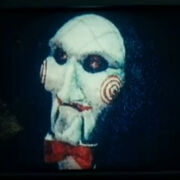
Billy the Puppet is the icon of the Saw franchise.
The start of the 2000s saw a quiet period for the genre. The re-release of a restored version of The Exorcist in September 2000 was successful despite the film having been available on home video for years. Franchise films such as Freddy vs. Jason also made a stand in theaters. Final Destination (2000) marked a successful revival of teen-centered horror and spawned four sequels. As well as the Jeepers Creepers series. Also, films like Wrong Turn, Cabin Fever, House of 1000 Corpses, and the previous mentions helped bring the genre back to Restricted ratings in theaters pleasing many hardcore horror fans.
Some notable trends have marked horror films in the 2000s. A French horror film Brotherhood of the Wolf became the second-highest-grossing French-language film in the United States in the last two decades. The Others (2001) was a successful horror film of that year. That film was the first horror in the decade to rely on psychology to scare audiences, rather than gore. A minimalist approach which was equal parts Val Lewton's theory of "less is more" (usually employing low-budget techniques seen on 1999's The Blair Witch Project) has been evident,[citation needed] particularly in the emergence of Asian horror movies which have been remade into successful Americanized versions, such as The Ring (2002), and The Grudge (2004). In March 2008, China banned the movies from its market.
There has been a major return to the zombie genre in horror movies made after 2000. The Resident Evil video game franchise was adapted into a film released in March 2002. Three sequels have followed. The British film 28 Days Later (2002) featured an update on the genre with The Return of the Living Dead (1985) style of aggressive zombie. The film later spawned a sequel: 28 Weeks Later. An updated remake of Dawn of the Dead (2004) soon appeared as well as the zombie comedy Shaun of the Dead (2004). This resurgence lead George A. Romero to return to his Living Dead series with Land of the Dead (2005), Diary of the Dead (2007) and Survival of the Dead (2010).
A larger trend is a return to the extreme, graphic violence that characterized much of the type of low-budget, exploitation horror from the Seventies and the post-Vietnam years. Films like Audition (1999), Wrong Turn (2003), and the Australian film Wolf Creek (2005), took their cues from The Last House on the Left (1972), The Texas Chain Saw Massacre (1974), and The Hills Have Eyes (1977). An extension of this trend was the emergence of a type of horror with emphasis on depictions of torture, suffering and violent deaths, (variously referred to as "horror porn", "torture porn", Splatterporn, and even "gore-nography") with films like The Collector, Saw, and Hostel, and their respective sequels, frequently singled out as examples of emergence of this sub-genre. Finally with the arrival of Paranormal Activity (2009), which had very good reviews and an excellent reception at the box office, minimal thought started by The Blair Witch Project was reaffirmed and is expected to be continued successfully in other low-budget productions.
Remakes
Remakes of earlier horror movies became routine in the 2000s. In addition to 2004's remake of Dawn of the Dead, as well as 2003's remake of both Herschell Gordon Lewis' cult classic 2001 Maniacs and the remake of Tobe Hooper's classic The Texas Chainsaw Massacre, there was also the 2007 Rob Zombie written and directed remake of John Carpenter's Halloween. The film focused more on Michael's backstory than the original did, devoting the first half of the film to Michael's childhood. It was critically panned by most, but was a success in its theatrical run. This success lead to the remakes, or "reimaginings" of other popular horror franchises with films such as Friday the 13th, A Nightmare on Elm Street (2010), and Children of the Corn. Other remakes include The Hills Have Eyes (2006), Prom Night (2008), and The Wolfman (2010).
